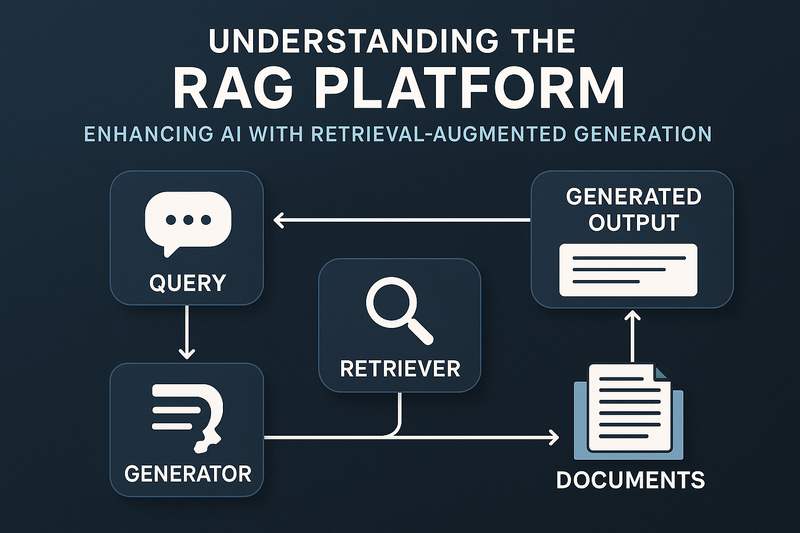In the evolving landscape of artificial intelligence (AI), large language models (LLMs) such as ChatGPT have revolutionized how machines understand and generate human-like text. However, despite their impressive capabilities, these models face challenges when it comes to providing accurate, up-to-date, and domain-specific responses. This is where the Retrieval-Augmented Generation (RAG) platform comes into play—a technological innovation that bridges the gap between powerful generative models and reliable data retrieval to enhance AI-driven interactions.
What is the RAG Platform?
The RAG platform refers to an AI framework that integrates two complementary AI approaches: retrieval-based systems and generative large language models. While traditional LLMs generate responses solely based on the data they were trained on, RAG platforms enhance this capability by dynamically retrieving relevant, current information from external knowledge bases or internal enterprise data sources. This allows the AI to generate responses grounded in factual, up-to-date content, significantly improving accuracy and relevance.
At its core, RAG works by first processing and indexing vast amounts of data—such as customer emails, support tickets, documents, or any unstructured information within an organization. When a query is posed, the system uses semantic search techniques to retrieve the most pertinent snippets of information. These snippets are then used as part of the input to the language model, guiding it to generate more informed and precise answers instead of relying solely on pre-trained knowledge.
How Does the RAG Platform Work?
Data Preprocessing and Indexing: The platform begins by gathering and organizing data—this can include proprietary company data, public datasets, documents, and other relevant information sources. The data is converted into a suitable format for rapid retrieval, often using vector embeddings that represent content in numeric form comprehensible to AI.
Semantic Retrieval: When a user submits a query, advanced semantic search techniques scan the indexed data to find the most relevant and contextually appropriate pieces of information related to the query.
Grounded Response Generation: The retrieved data snippets are then incorporated into the input prompt for the large language model. The LLM uses these to generate a response that is both contextually rich and factually grounded, improving the reliability and specificity of the answer.
This method not only enhances factual accuracy but also reduces the risk of "hallucinations," where generative models produce plausible but incorrect or fabricated information.
Benefits of Using a RAG Platform
Improved Accuracy and Relevance: By incorporating real-time or domain-specific data, the RAG platform ensures responses are more accurate and tailored to the specific context or needs of an enterprise.
Up-to-Date Information: Unlike traditional LLMs bound by the knowledge cutoff of their training data, RAG can access and incorporate the latest information, making it highly valuable for use cases that demand current data.
Cost Efficiency: Since RAG platforms retrieve information rather than requiring constant retraining of large models, organizations can save computational resources and operational costs.
Transparency and Trust: Because the system can cite the sources of the information used to generate responses, users gain visibility and confidence in AI outputs, which is critical for enterprise adoption.
Versatility Across Industries: RAG platforms can be applied in diverse sectors such as customer service, sales, marketing, and commerce, where leveraging proprietary data alongside generative capabilities can transform workflows and customer interactions.
Types of RAG Architectures
Several variations of RAG architectures exist to optimize the retrieval and generation process:
Vector-based RAG: Uses vector databases to represent data in numerical arrays, enabling efficient similarity search and retrieval.
Knowledge Graph RAG: Organizes information as nodes and relationships, allowing the system to draw complex, human-like connections between concepts.
Ensemble RAG: Combines the outputs of multiple retrievers for more reliable responses, cross-verifying to mitigate weaknesses of individual models.
Real-World Applications of the RAG Platform
In practice, RAG platforms have enabled a new generation of AI agents that act as intelligent assistants integrated with enterprise systems. Examples include:
Customer Support: AI agents can access customer history and internal knowledge bases to provide personalized, proactive service quickly and accurately.
Sales Enablement: RAG-enhanced agents can autonomously nurture leads, provide sales coaching, and optimize pipeline management based on real-time CRM data.
Marketing: Marketing teams leverage AI agents for personalized content generation, campaign optimization, and customer engagement insights by processing current brand guidelines and customer data.
E-commerce: AI agents can create personalized shopping experiences, manage inventory data and streamline product information management, improving both customer satisfaction and operational efficiency.
How to Get Started with a RAG Platform
Businesses interested in leveraging RAG technology should start by identifying valuable data sources that complement their existing AI models. Connecting these sources through semantic indexing and searching capabilities will allow them to enhance their large language models with relevant, actionable insights. Collaboration between data engineering, AI, and business teams is critical to tailor the platform to specific needs and goals.
Leading cloud providers and AI companies offer tools and frameworks to facilitate the deployment of RAG architectures, making it more accessible for organizations of all sizes to benefit from this powerful technology.
Conclusion
The RAG platform represents a significant advancement in AI technology by combining the creativity of generative models with the precision of retrieval systems. It enables organizations to build AI solutions that are not just conversationally capable but also grounded in factual and current information. As businesses continue to seek smarter automation and more insightful AI applications, the RAG platform will play a pivotal role in driving trustworthy, effective, and data-enriched AI interactions.
By blending generative AI with sophisticated retrieval techniques, the RAG platform offers a compelling solution for enterprises aiming to harness the full potential of artificial intelligence while mitigating risks related to accuracy, relevance, and data freshness.




Top comments (0)